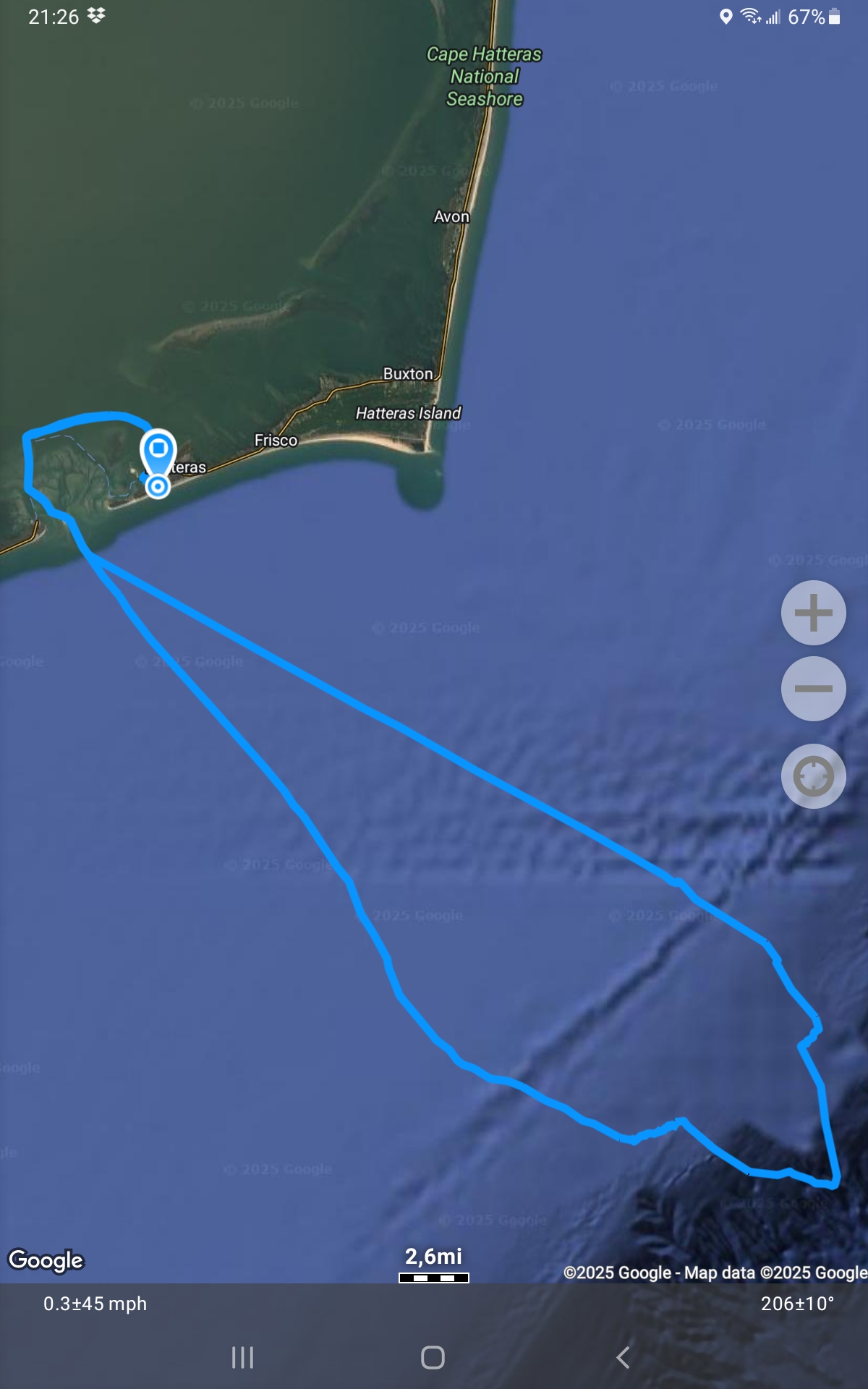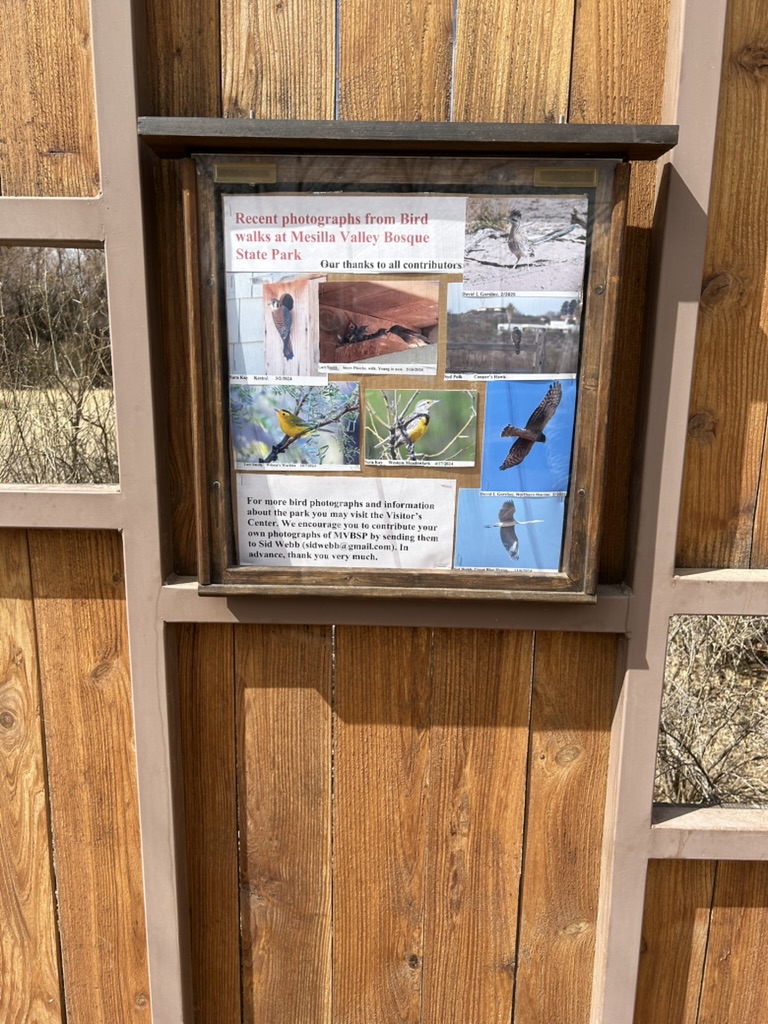 I took my first birding trip with Victor Emanuel Nature Tours (VENT), running up the coast from Wilmington, N.C. to Norfolk, Va. Kevin Burke was our excellent guide, always making sure that everyone got on the bird at hand—not to mention handling the driving (always ready to give an extra lift not on the tour), lodging logistics, and finding tasty restaurants. We were five participants; here’s Kevin in the lead of the other four on the beach near Oregon Inlet.
I took my first birding trip with Victor Emanuel Nature Tours (VENT), running up the coast from Wilmington, N.C. to Norfolk, Va. Kevin Burke was our excellent guide, always making sure that everyone got on the bird at hand—not to mention handling the driving (always ready to give an extra lift not on the tour), lodging logistics, and finding tasty restaurants. We were five participants; here’s Kevin in the lead of the other four on the beach near Oregon Inlet.

 I rode Amtrak to get to Tidewater, but since the tour was one-way, I needed to bridge the gap between the cities. I hopped a Greyhound/FlixBus for the first time in decades. While the coach was quite comfortable, I needn’t have paid for a double seat because there were few riders. As I expected from the barebones stop at Union Station here in D.C., most bus stations these days are tragically spartan, with no options for food or toilets. We pulled in to parking lots and abandoned gas stations. Here’s one exception: a spiffy new transit hub in Greenville, N.C. Ha! Closed on Saturday.
I rode Amtrak to get to Tidewater, but since the tour was one-way, I needed to bridge the gap between the cities. I hopped a Greyhound/FlixBus for the first time in decades. While the coach was quite comfortable, I needn’t have paid for a double seat because there were few riders. As I expected from the barebones stop at Union Station here in D.C., most bus stations these days are tragically spartan, with no options for food or toilets. We pulled in to parking lots and abandoned gas stations. Here’s one exception: a spiffy new transit hub in Greenville, N.C. Ha! Closed on Saturday.
 Sunday was our first day out birding. Kevin had scouted a little-known corner of pine forest where Red-cockaded Woodpecker (Dryobates borealis) could be found, answering its wake-up call at 07:15. At Orton Pond, a very cooperative Prothonotary Warbler (Protonotaria citrea) turned up, as well as an American Alligator (Alligator mississippiensis) that slunk through the water. Down the road my first lifer for the trip arrived, Bachman’s Sparrow (Peucaea aestivalis).
Sunday was our first day out birding. Kevin had scouted a little-known corner of pine forest where Red-cockaded Woodpecker (Dryobates borealis) could be found, answering its wake-up call at 07:15. At Orton Pond, a very cooperative Prothonotary Warbler (Protonotaria citrea) turned up, as well as an American Alligator (Alligator mississippiensis) that slunk through the water. Down the road my first lifer for the trip arrived, Bachman’s Sparrow (Peucaea aestivalis).
After lunch, I started to learn the handful of seaside plants, among them Coastal Water-pennywort (Hydrocotyle bonariensis), American Sea Rocket (Cakile edentula), and Saw Greenbrier (Smilax bona-nox).
The next day, Kevin improvised a ferry trip to Shackleford Banks, where I found a beautiful new tiger beetle for me, Eastern Beach Tiger Beetle (Habroscelimorpha dorsalis) (woot!) (likely ssp. media), and a robber fly that predates on the tiger beetle, Sand Hammertail (Efferia albibarbus) (woot-woot!).
And then, mostly a travel day to Hatteras on two care ferries, but we did stop at a boat launch access road for another lifer and long-tormenting nemesis bird, Least Bittern (Botaurus exilis).

 Wednesday was scheduled for a pelagic trip, but the weather had other plans, as the surf at Avon Pier illustrates. So once again Kevin cooked up some good birding, including a visit to Bodie Island Lighthouse. The Dancing Turtle in Hatteras is a good place for early morning coffee and pastries, but skip the bagels. (David’s new rule: Don’t order bagels in a shop without “bagels” in its name.)
Wednesday was scheduled for a pelagic trip, but the weather had other plans, as the surf at Avon Pier illustrates. So once again Kevin cooked up some good birding, including a visit to Bodie Island Lighthouse. The Dancing Turtle in Hatteras is a good place for early morning coffee and pastries, but skip the bagels. (David’s new rule: Don’t order bagels in a shop without “bagels” in its name.)
 Thursday we got out on to the water: we were advised that it would be “sporty” and “confused.” Indeed. For the first time in decades, I joined the Fellowship of Ralph. But after tossing all of my skimpy breakfast and coffee, and having a bit of a lie-down, I roused myself to photograph four lifers, including two storm-petrels, Wilson’s (Oceanites oceanicus) and Band-rumped (Hydrobates castro). Also spotted: several flying fish and a Portuguese Man O’ War (Physalia physalis)—surprisingly tiny. The captain of our boat could take a note from VENT on customer service and being welcoming.
Thursday we got out on to the water: we were advised that it would be “sporty” and “confused.” Indeed. For the first time in decades, I joined the Fellowship of Ralph. But after tossing all of my skimpy breakfast and coffee, and having a bit of a lie-down, I roused myself to photograph four lifers, including two storm-petrels, Wilson’s (Oceanites oceanicus) and Band-rumped (Hydrobates castro). Also spotted: several flying fish and a Portuguese Man O’ War (Physalia physalis)—surprisingly tiny. The captain of our boat could take a note from VENT on customer service and being welcoming.
Takeaways:
- Shutter priority is your friend. The bird is moving in three dimensions, and the boat is moving in three different dimensions.
- You’re not too old for dramamine.
We wrapped up the tour, skirting the Great Dismal Swamp. Seven life birds for me; the group got skunked on Belted Kingfisher (?!). I have a thing for Boat-tailed Grackle (Quiscalus major).
Your Eastern North Carolina dialect word is preesht, that is, “I appreciate it,” otherwise, “thank you.”















